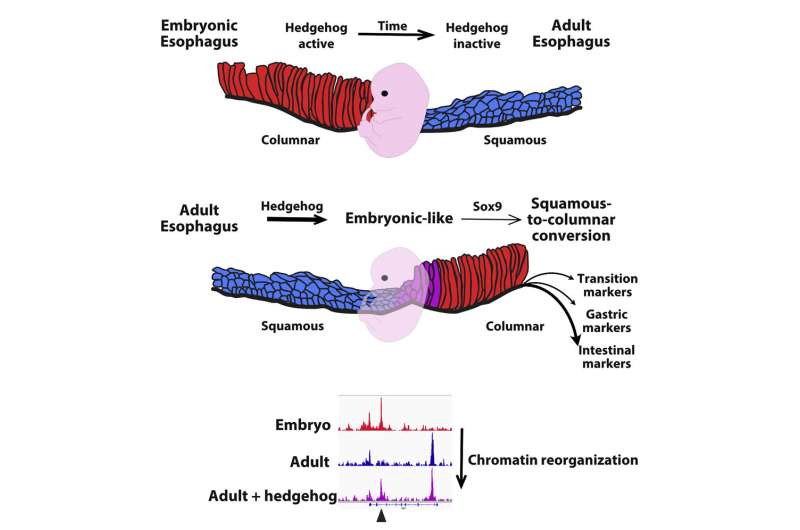Esophageal cancer: Discovery of the mechanisms involved

Metaplasia is defined as the replacement of a fully differentiated cell type by another. There are several classical examples of metaplasia, one of the most frequent is called Barrett's esophagus. Barrett's esophagus is characterized by the replacement of the keratinocytes by columnar cells in the lower esophagus upon chronic acid reflux. This metaplasia is considered a precancerous lesion that increases by around 50 times the risk of this oesophageal adenocarcinoma. Nonetheless, the mechanisms involved in the development of metaplasia in the esophagus are still partially unknown.
In a new study published in Cell Stem Cell, researchers led by Mr. Benjamin Beck, (FNRS research associate and WELBIO investigator at the IRIBHM, Université libre de Bruxelles, Belgium), report the mechanisms involved in the transdifferentiation of oesophageal keratinocytes into columnar cells.
Alizée Vercauteren Drubbel and colleagues used state-of-the-art genetic tools and mouse models to dissect the molecular mechanisms by which cells from the esophagus can participate to metaplasia. In collaboration with Prof. Sachiyo Nomura (Tokyo Medical University, Japan), they demonstrated that the reactivation of the Hedgehog pathway occurs in epithelial cells upon chronic acid reflux. The sole reactivation of this pathway in normal oesophageal cells changes them and make them look like embryonic oesophageal cells. Subsequently, a subset of these cells is converted into columnar cells. "It was really surprising to see the cells from the esophagus slowly changing over time and getting features of other tissues just by activating a signaling pathway in vivo" comments Alizée Vercauteren Drubbel, the first author of this study.
The authors demonstrate that the hedgehog pathway alters the squamous differentiation program in virtually all the oesophageal cells but induces a full squamous-to-columnar conversion in a subset of progenitors only. Interestingly, an embryonic-like epigenetic and transcriptomic program precedes the columnar conversion, suggesting that keratinocytes need to be dedifferentiated before activating another differentiation program. Conditional knockout in vivo demonstrates that the transcription factor Sox9 plays a pivotal role in the process of columnar conversion.
In conclusion, this work highlights mechanisms modulating cellular plasticity that may constitute the very first step of transdifferentiation and metaplasia development in the esophagus. Oesophageal adenocarcinoma incidence has dramatically increased over the past decades. This increase appears to be a result of the increased prevalence of Barrett's esophagus. Hence, "we hope that a better understanding of the processes involved in the development of metaplasia and their progression into cancer will help detecting people with a high risk of developing cancer." comments Benjamin Beck, the last and corresponding author of this study.
More information: Alizée Vercauteren Drubbel et al. Reactivation of the Hedgehog pathway in esophageal progenitors turns on an embryonic-like program to initiate columnar metaplasia, Cell Stem Cell (2021). DOI: 10.1016/j.stem.2021.03.019

















